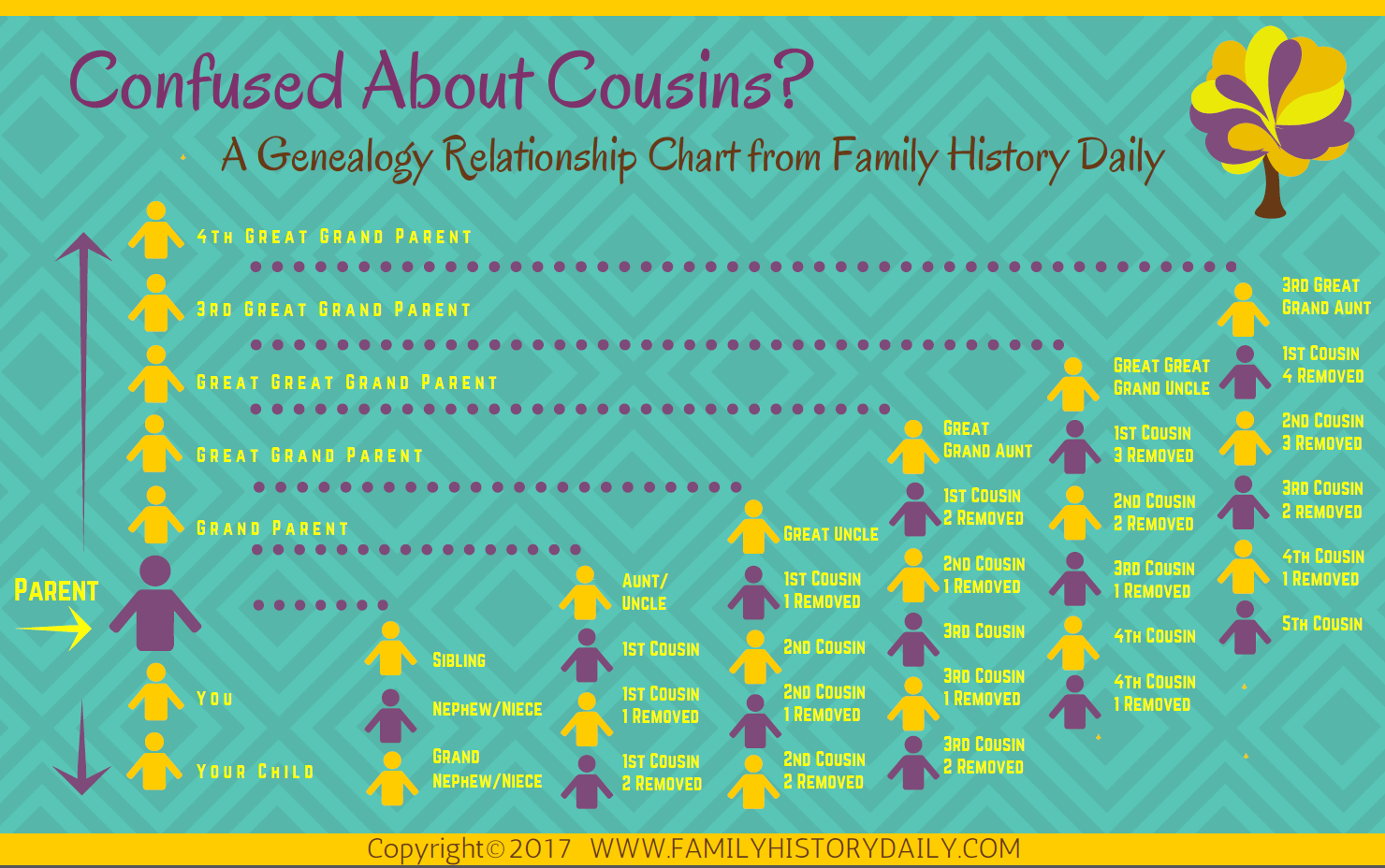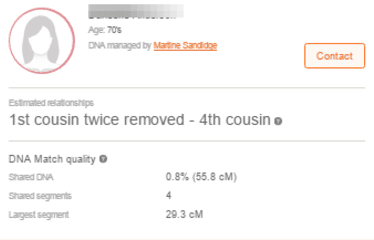If you’ve been looking through DNA matches recently, or connecting with distant cousins through traditional genealogy research, you’ve likely found yourself wondering, “If I share a 2nd great grandparent with someone what kind of cousins are we?” “What is a 3rd cousin twice removed anyway?”
You’re not the only one. Cousin relationships are complex and keeping all of them straight can be very confusing. Many of us have to look these relationships up when we encounter them just to make sure we’ve got our facts straight. That’s why we decided to create a simple family relationship chart to help you – along with instructions for using it. The chart found below can be viewed here at any time, saved to your computer or printed off for easy reference.
Family Relationship Chart for Genealogy
Viewing and Saving This Chart
To view a larger version of the chart you can click on it.
You can save the above image just as you would any image online – such as by right-clicking and hitting “save as” or long pressing on mobile and selecting download.
If you prefer to print the chart or save it in a PDF file we have included one here.
How to Use the Family Relationship Chart
You can use the chart above in two ways. The first will be most useful when you already know what your most recent common ancestor is with another person and you would like to discover what your relationship is with that person.
The second method will be useful when you are doing DNA research and your match is listed as possibly having a certain relationship to you (as seen in the screenshot below) and you would like to understand what that means.
Method 1: Finding Your Cousin Relationship
If you know your most recent common ancestor with another person then you can use this relationship chart to figure out what your familial relationship is. Start by following your own line up the left side of the chart. Follow it from yourself to your parent to the generation you connect at with the other person.
Next, follow the purple dots over from that ancestor to the right until you come to the generations listed at the end of that purple dotted line. Now follow the generations down (the yellow and purple people icons). When you do this you are moving forward in time one generation for each level.
As an example, let’s say you’ve connected with a person through your genealogy research and you’ve discovered that you have a 2nd great grand parent in common. You are both descended from this great great grandparent, but from different children of that person. The great great grandparent is your most recent common ancestor.
To figure out how you are related you would travel up to great great grandparent on the chart (on the left side) and then follow the purple dots over to the corresponding area on the right. You will now need to travel down through the people icons in this line until you reach the correct generation.
Since your great great grandparent is also the great great grandparent of the person you are connected to, you would count the first person in this line (listed as great grand aunt/uncle) as their great grand parent. This is because your relation’s great grandparent was the sibling of your great grandparent.
Next you would move down one more generation on the chart (which is forward a generation in time) and get to your relation’s grandparent (your 1st cousin twice removed) and then you move down one more to get to your relation’s parent (your second cousin once removed) and then down one more to the person you have connected with. This makes them your third cousin.
But what if the most recent common ancestor you share with a person is your great great grandparent but is your relation’s great grandparent? Simply move back a generation (up through the people icons on the relationship chart) to discover that this person is your second cousin once removed. If your cousin was related to your 2nd great grandparent by being their 3rd great grandchild you would move down through the icons until you reached a proper number of generations from the shared ancestor – and you would find that you are 3rd cousins once removed.
Now you try it. If you connect to a new relation and their 4th great grandparent is your 3rd great grandparent how would you be related? Use the chart above to figure this out. The answer is at the bottom of this post.
Method 2: Determining Your Shared Ancestor
This method can be used when you already know or suspect how you are related to someone and you want to see where your shared ancestor might be. To use this method simply find your relationship on the chart, follow the generations back in time until you get to the purple dots and then over to your generational line on the left.
Let’s imagine, for instance, that you are looking at your DNA matches and you see a possible 2nd to 3rd cousin. While remembering that such genetic relationships are best guesses of generational distance and are not exact – take a moment to find 2nd cousin on the chart. Follow the people icons up to the purple dots and then over to the left. This would show that you may share a great grandparent with that person.
Now take a look at the 3rd cousin area and do the same thing – up and then over. You will find that if you are 3rd cousins you may share a great great grandparent in common. You will see that some relationships are shown more than once since there is more than one possibility for connection.
The number of years between generations can vary widely from family to family so, while you may share an ancestor with a person and be descended from that ancestor as their 3rd great grandchild, a person nearly your same age may be one or even two generations removed (meaning that your 3rd great might be their 2nd great – or their 4th). OR you may actually share a more recent or distant common ancestor.
If a person is much older or younger than you this increases the possibility of generational removal even more. When using this chart for unproven DNA matches remember that the relationships provided by testing companies are guesses based on the amount of DNA you share with someone. There are many factors that come in to play that may alter the actual relationship you share. You can learn more about this in our online genealogy course.
However you choose to use this family relationship chart we hope it will help you make sense of this confusing topic. Enjoy!
Answer: 4th cousin once removed. You would select 3rd great grandparent from the left side of the chart, since that is how you are related to your most recent common ancestor, then move over to the corresponding generations (people icons) and count down. Since your 3rd great grandparent is their 4th, your great great grand uncle is their 3rd great grandparent, your 1st cousin 3 times removed is their great great grandparent, your 2nd cousin twice removed is their great grandparent, your 3rd cousin once removed is their grandparent and your 4th cousin is their parent.
By Melanie Mayo, Editor, and Kate Jackson, Associate Editor, Family History Daily



Judith, Have you tried using the Shared cM Project at thegeneticgenealogist.com? Or the What are the Odds (WATO) tool at DNApainter.com (which also links to the Shared cM Project)? (Both offer useful free versions.) You may get some clarity on the relationships to your cousins and your bio father. The usefulness of these tools can depend on the accuracy of your genealogical research where it can be known (like confirming who each putative father’s knwon children and descendants are), but they also allow for you to try different hypothetical relationships and calculate the odds for the possibility of those relationships.
When I get second and third matches that are related to me that show up as a possible to a family name which one of the three brothers could be my father ? My mother lied to me about the guy she had divorced and try to pass him off as my father . She and the others have passed away . The children of the brother’s will not do a DNA test , but my matches are coming from their children . I would like to be able to say for sure these people are my biological family . Thanks
Hi Diana,
If you do not have Pinterest added to your browser please use the P button at the bottom of the article (next to where is says the number of shares).
Thanks 🙂
Would bee great if this site allowed us to pin these posts to Pinterest~
Surely it depends what country you’re in! I understand that the US uses different terminology. In UK my grandmother’s brother has always been my GREAT-uncle. ‘Grand-uncle’ makes more sense but I’ve never heard it used here!
Sara, in my area, we always called the siblings of our grandparents “great-aunts and great-uncles.” Since my parents’ siblings were my “aunts and uncles”, it always made sense that the aunts and uncles one generation beyond were “great aunts and great uncles.” I can see that the “GRAND aunt/uncle does make sense. But, I am 75 years old so I will probably stick with tradition, but thanks for sharing the interesting variation..
I won’t recommend this chart because you use the term great uncle/aunt instead of grand uncle/aunt. The siblings of a GRANDparent are GRAND uncles or GRAND aunts. The siblings of GREAT GRANDparents are GREAT GRAND aunt/uncles. You have the great grand aunt/uncle correct but not the grand aunt/uncle label.
Thank you for your blog.